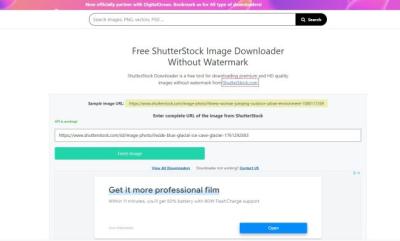Have you ever snapped a photo during your daily routine and wondered if it could make you some extra cash? Well, you’re in luck! Shutterstock is a popular platform where photographers and hobbyists alike can turn their everyday photos into a source of income. Whether it’s a shot of your morning coffee, a scenic park visit, or a candid street scene, your photos might just find a new home—and bring in some revenue. In this post, we’ll explore how you can leverage your everyday images to earn money on Shutterstock, making your photography hobby more rewarding and profitable.
Understanding Shutterstock’s Contributor Program

Before you start uploading, it’s important to understand how Shutterstock‘s contributor program works. Essentially, Shutterstock is a marketplace that connects contributors—people like you who upload photos—with buyers looking for images to use in their projects. As a contributor, you earn money each time your photo is downloaded or licensed. The more high-quality, appealing photos you upload, the more potential income you can generate.
Here’s a quick rundown of how the program works:
- Sign Up: Create a free contributor account on Shutterstock’s website. You’ll need to provide some basic information and agree to their terms.
- Upload Photos: Submit your images via their online uploader or mobile app. Make sure your photos meet their technical and quality standards.
- Keyword and Categorize: Add relevant keywords and categories to help buyers find your images easily.
- Get Approved: Shutterstock reviews your submissions to ensure they meet quality guidelines. Once approved, your photos go live in the marketplace.
- Earn Royalties: When someone downloads or licenses your photo, you earn a royalty. The amount varies based on your contributor level and the licensing type.
It’s a straightforward process, but success depends on consistently uploading good photos, understanding what buyers are looking for, and optimizing your images with effective keywords. The platform also provides helpful resources and tips to improve your chances of earning more. So, if you’ve got a collection of everyday photos gathering dust, why not turn them into cash? It’s a simple, flexible way to monetize your photography skills without needing fancy equipment or a studio setup.
Tips for Taking High-Quality Everyday Photos
Getting great photos that stand out on Shutterstock doesn’t always mean you need a fancy camera or a professional setup. Sometimes, your everyday moments are the most authentic and appealing, especially if you follow a few simple tips to elevate their quality. Here’s how you can capture high-quality, market-ready images with tools and techniques you already have:
1. Focus on Lighting: Natural light is your best friend. Shoot during the golden hour—early morning or late afternoon—when sunlight is soft and warm. Avoid harsh midday sun, which can create unflattering shadows. If indoors, position your subject near windows and use diffused light to avoid glare.
2. Keep It Sharp: Use your camera or smartphone’s autofocus to ensure your subject is crisp. Tap on the screen to focus precisely, especially if photographing small objects or details. Steady your shot by holding your device with both hands or using a simple tripod or stabilizer.
3. Mind the Composition: Follow basic principles like the rule of thirds—place your main subject along the gridlines for a balanced and engaging photo. Don’t be afraid to experiment with angles and perspectives to add interest.
4. Declutter and Simplify: Clear the background of distractions to make your subject pop. Sometimes, a clean, simple background works best for stock photos, as it provides space for potential editing or overlay text.
5. Capture Candid Moments: Authenticity sells. Take photos of real-life activities—people working, cooking, relaxing, or enjoying hobbies. These relatable scenes resonate well with buyers looking for genuine content.
6. Edit Thoughtfully: Basic editing can make a big difference. Use free or affordable tools to adjust brightness, contrast, and sharpness. Avoid over-editing; keep images natural and true to life.
Remember, the key is to practice and observe what works best. The more you experiment with your everyday photos, the more you’ll develop your eye for capturing shots that not only look great but also have the potential to earn you money on Shutterstock.
Best Practices for Uploading and Tagging Your Photos
Once you’ve taken a collection of high-quality photos, the next step is ensuring they’re optimized for Shutterstock’s marketplace. Proper uploading and tagging are crucial because they help your images get seen by the right buyers. Here’s a simple guide to get your photos ready for submission:
1. Prepare Your Files: Make sure your images are in the correct format—JPEG is standard—and have a minimum resolution of 4 megapixels. Compress your files to balance quality and upload speed, but avoid losing too much detail.
2. Write Clear and Descriptive Titles: Your title should accurately describe the photo. Instead of vague titles like “IMG_1234,” use something informative like “Cropped shot of a person typing on a laptop in a cozy coffee shop.” Clear titles help buyers find your images in searches.
3. Craft Effective Descriptions: Use the description box to add context. Mention the location, mood, colors, or any relevant details. Think about what a buyer might search for—be specific and natural in your language.
4. Use Relevant and Specific Tags: Tags are your best tools for discoverability. Use keywords that describe the subject, setting, mood, and potential uses. For example, if you uploaded a photo of a dog playing in the park, tags might include dog, pet, park, outdoor, playful, animal, nature. Include both broad and niche keywords.
5. Follow Shutterstock’s Guidelines: Make sure your photos are free of watermarks, logos, or copyrighted content. Avoid over-using model or property releases unless necessary. Read their contributor guidelines carefully to ensure compliance.
6. Categorize Your Photos Correctly: Assign your images to the appropriate categories and subcategories. Proper categorization makes it easier for buyers to find your images when browsing.
7. Consistency Is Key: Regularly upload new photos with good titles, descriptions, and tags. The more quality content you provide, the better your chances of earning money and building a portfolio that attracts repeat buyers.
In summary, taking the time to optimize your uploads with thoughtful tags and accurate descriptions can significantly boost your visibility on Shutterstock. It’s all about making your images as discoverable and appealing as possible to potential buyers.
Strategies to Increase Your Photo Sales on Shutterstock
So, you’re already uploading photos to Shutterstock — that’s a fantastic start! But if you want to really boost your earnings, it’s all about being strategic. Here are some tried-and-true strategies to help your photos stand out and sell more:
Optimize Your Keywords
Think of keywords as the signposts guiding buyers straight to your images. Use descriptive, relevant, and specific keywords that accurately reflect your photo. Don’t just settle for obvious keywords like “dog” or “beach” — get detailed! For example, instead of just “mountain,” try “snow-capped mountain during sunrise.” Use all available keyword slots and think about what potential buyers might search for.
Focus on Trends and Seasonal Content
Keep an eye on current trends and seasonal themes. If you notice a rising trend in remote work, sustainability, or health, try to capture images that fit those themes. Seasonal content like holidays, spring blooms, or summer vacations always has demand. Uploading timely content increases your chances of being discovered during peak buying periods.
Consistent Uploads and Quality
Consistency is key. Regularly uploading fresh images keeps your portfolio active and increases your chances of being featured or appearing in search results. Also, prioritize quality over quantity. Well-composed, sharp, and well-lit photos attract more buyers and earn higher royalties.
Engage in Your Portfolio
Take the time to update and organize your portfolio. Remove underperforming images and highlight your best work. Use collections and curated portfolios to showcase themed sets of photos, making it easier for buyers to find what they need.
Leverage Social Media and Personal Networks
Share your Shutterstock portfolio on social media platforms, blogs, or personal websites. The more exposure your images get, the higher the chances of someone purchasing them. Building a community around your photography can lead to more visibility and sales.
Common Mistakes to Avoid as a Shutterstock Contributor
While uploading your photos to Shutterstock can be lucrative, there are some common pitfalls that can hinder your success. Avoiding these mistakes will help you build a stronger, more profitable portfolio:
Ignoring Image Quality
Low-quality images are a quick way to get rejected or earn fewer sales. Always ensure your photos are sharp, well-exposed, and free of noise or distractions. Use good editing tools to enhance your images without overdoing it.
Overusing Generic Keywords
Using vague or overly broad keywords makes it harder for your images to be discovered. Be specific and avoid stuffing keywords that don’t truly describe the photo. Always think about what a buyer searching for that image would type.
Uploading Irrelevant or Poorly Composed Photos
Only upload images that meet Shutterstock’s guidelines and are relevant to potential buyers. Avoid blurry, poorly composed, or overly edited photos. Remember, your goal is to provide high-quality visuals that add value.
Not Paying Attention to Trends and Market Demand
Uploading only niche or outdated content can limit your sales. Stay informed about current market demands and trending topics. Use Shutterstock’s trending collections or explore popular categories to guide your uploads.
Neglecting Metadata and Descriptions
Failing to fill out descriptions, titles, and keywords thoroughly can hurt your visibility. Take the time to craft clear, accurate, and engaging metadata. Think from the buyer’s perspective—what would they search for?
Ignoring License and Usage Restrictions
Be aware of licensing rules, model releases, and property releases. Uploading images with unlicensed people or private property can cause issues later. Always ensure you have the right permissions to sell your photos.
By steering clear of these common mistakes and implementing smart strategies, you’ll be well on your way to increasing your Shutterstock earnings and building a thriving photography business. Happy uploading!
How to Maximize Your Earnings with Consistent Uploads
One of the most effective ways to boost your income on Shutterstock is by maintaining a steady stream of high-quality uploads. Think of it like building a portfolio of your best work over time—they all add up and can generate more sales. When you upload consistently, your portfolio stays fresh, and Shutterstock’s algorithm is more likely to recommend your photos to users actively searching for content.
Here are some practical tips to help you stay consistent:
- Create a content schedule: Decide how often you’ll upload—whether it’s weekly or bi-weekly—and stick to it. Setting a routine helps you stay motivated and ensures you don’t fall behind.
- Batch your photo editing: Instead of editing each photo as you upload, consider batching your editing sessions. This way, you can process multiple images at once, saving time and keeping your uploads steady.
- Plan your shoots around trending topics: Keep an eye on current trends or seasonal themes. Uploading relevant content promptly increases the chances of your photos being discovered and purchased.
- Organize your library: Maintain an organized catalog of your shots so you can quickly find and upload new content without hassle.
Remember, quality always beats quantity, but consistently adding new content helps you stay visible and relevant. The more diverse and fresh your portfolio, the more opportunities you have to earn from various types of buyers.
Don’t get discouraged if some uploads don’t sell immediately. Over time, as your collection grows and you refine your style based on what sells best, your earnings can increase significantly. Think of it as planting seeds—you’ll harvest the rewards later!
Additional Tips for Success in Stock Photography
Getting started is just the first step. To truly succeed on Shutterstock, you’ll want to adopt some smart strategies that set you apart from the crowd. Here are some additional tips to help you thrive in the world of stock photography:
- Focus on keywording: Use descriptive, relevant keywords to make your photos discoverable. Think about what buyers might search for—include synonyms and related terms. Well-optimized keywords can dramatically increase your visibility.
- Pay attention to technical quality: Ensure your images are sharp, well-lit, and correctly exposed. Avoid noise, blurriness, or distracting elements. High-quality images are more likely to be accepted and purchased.
- Stay within Shutterstock’s guidelines: Familiarize yourself with their content policies to avoid rejection. Avoid prohibited content like logos, watermarks, or copyrighted material that you don’t own.
- Specialize in a niche: While variety is good, becoming known for a particular style or subject can help you attract repeat buyers. Whether it’s nature, business, lifestyle, or food, developing expertise here can pay off.
- Engage with the community: Participate in forums or social media groups related to stock photography. Networking can provide inspiration, feedback, and even collaborations that boost your growth.
- Analyze your performance: Regularly review which photos sell best and why. Use this insight to guide future shoots and keywording strategies.
Lastly, patience and persistence are key. Success in stock photography doesn’t happen overnight, but with consistent effort, attention to quality, and smart marketing, you’ll increase your chances of earning steady income on Shutterstock. Keep experimenting, learning, and uploading—your future earnings depend on it!
Conclusion and Next Steps to Start Earning on Shutterstock
Getting started on Shutterstock as a contributor is an exciting opportunity to turn your everyday photos into a steady stream of income. By understanding the platform’s requirements and optimizing your submissions, you can increase your chances of success. Remember, consistency and quality are key to building a reputable portfolio that attracts buyers.
Here are some next steps to help you begin your journey:
- Create a Shutterstock Contributor Account: Sign up at the Shutterstock Contributor portal and familiarize yourself with their guidelines.
- Curate Your Best Photos: Select high-quality, well-lit images that are relevant and appealing to potential buyers.
- Optimize Your Uploads: Use descriptive, keyword-rich titles and tags to improve search visibility.
- Stay Consistent: Regularly upload new content to keep your portfolio active and increase your chances of sales.
- Learn and Adapt: Review your sales data and popular trends to refine your photo selection and improve your earnings.
By following these steps, you’ll be well on your way to earning money from your everyday photos on Shutterstock. Patience and persistence will pay off as you build a diverse and attractive portfolio. Start today, and turn your passion for photography into a profitable venture!


